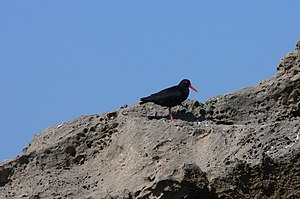Black oystercatcher
| Black oystercatcher | ||||||||||||
|---|---|---|---|---|---|---|---|---|---|---|---|---|

Black oystercatcher ( Haematopus moquini ) |
||||||||||||
| Systematics | ||||||||||||
|
||||||||||||
| Scientific name | ||||||||||||
| Haematopus moquini | ||||||||||||
| Bonaparte , 1856 |
The black oystercatcher ( Haematopus moquini ), also known as the African black oystercatcher, belongs to the order of waders, gulls and alken birds ( Charadriiformes ). The species occurs only in the coastal areas of southern Africa and New Zealand.
Appearance
In contrast to the oystercatcher observed in the European Wadden Sea , it is an almost completely black to brown-black bird. Occasionally a few white feathers can only be found on the inner wings of the hand . The beak is red and has an orange-yellow tip. The legs are flesh-colored. In young birds, the feather edges are light and the beak and the iris are duller in color.
Distribution area and habitat
The black oystercatcher breeds on the coasts from Angola to South Africa . It can be seen on a number of different coastal areas, ranging from flat sandy beaches to rocky shorelines. The total population is estimated at 5,000 to 6,000 specimens. The species is classified as near threatened by the IUCN . Although the population has recovered in recent years, it is still very small overall. The problem is that the reproductive time coincides with the time in which there are increased leisure activities in the coastal areas. Areas in which cars are allowed to drive on the beach zone are particularly problematic. Here nests are regularly destroyed by vehicles and young birds run over. A ban on vehicles in the immediate beach area has led to an increase in the population in South Africa.
Black oystercatchers are predominantly resident birds , but a regionally limited migration can be identified. During the breeding season, they move from the predominantly rocky coastal areas to those with a more sandy shoreline. In ideal habitats such areas are close together. Occasionally, they can still be observed inland when adverse weather conditions prevail on the coastal areas.
Reproduction
The breeding season falls in the months of October to April, the main breeding season is December and January. Clutches usually consist of two and more rarely one or three eggs. The breeding period is 32 days and the young birds fledged after forty days. Both parent birds are involved in the incubation of the eggs and in guiding the young birds. About 0.3 to 0.6 young birds per pair are raised on islands off the coast. The breeding success is significantly lower on the mainland, where the risk of loss through human leisure activities and the risk of predation is higher.
Systematics
The endemic and now extinct Canary Island oystercatcher , which used to be seen on the Canary Islands Graciosa , Lanzarote and Fuerteventura , is occasionally classified as a subspecies of the black oystercatcher. For the most part, however, the black oystercatcher is treated as a monotypical species.
supporting documents
literature
- Simon Delany, Derek Scott, Tim Dodman, David Stroud (Eds.): An Atlas of Wader Populations in Africa and Western Eurasia. Wetlands International , Wageningen 2009, ISBN 978-90-5882-047-1 .
Web links
- Haematopus moquini in the endangered Red List species the IUCN 2008. Posted by: BirdLife International, 2008. Accessed January 31 of 2009.
- Videos, photos and sound recordings of Haematopus moquini in the Internet Bird Collection
Single receipts
- ^ A b Simon Delany, Derek Scott, Tim Dodman, David Stroud (Eds.): An Atlas of Wader Populations in Africa and Western Eurasia. Wetlands International , Wageningen 2009, ISBN 978-90-5882-047-1 , p. 43.
- ↑ Delany et al., P. 41.